During his Formula 1 career Jacques Villeneuve bore two crosses: living in the shadow of his legendary (departed) father Gilles – whom he barely knew yet is invariably compared with – and a comet-like record, one that flared early, then left a lingering tail.
The French Canadian arrived in F1 with Williams from a successful 1994 and 1995 CART IndyCar campaigns, winning both the US championship and Indianapolis 500. That attracted the attention of team boss Frank Williams, team sponsors Rothmans and engine supplier Renault.Such was his bargaining power that Villeneuve and manager Craig Pollock demanded – and got – unprecedented transitional test mileage with the FW17 which had taken Damon Hill to second behind Michael Schumacher and Benetton in the 1995 F1 championship. They tested mainly at Estoril, although Paul Ricard, Silverstone (“when it wasn’t raining”) and Imola were also on the schedule, as was Nogaro in preparation for Monaco.
He is estimated to have covered around 10,000km. “Lots of mileage,” he recalls, “a bunch of grands prix distance-wise; at least three or four days a week: November, halfway through December, whole month of January and part of February. By the time we jumped into [the FW18] a lot of mileage had been done on the old car with bits from the new car.”
His first impressions were that the F1 car had less power (“no turbo”), but that, “You couldn’t drive nicely and calmly like in an IndyCar. You had to fight and muscle through every corner, braking was hard and the cars were very stiff as well, like a go-kart.”
The rubber was, though, familiar: At the time both categories used Goodyear tyres which had similar construction. The FW17 had obviously been developed around the taller Hill, but Villeneuve says, “Everything was a lot more refined, and obviously the gearbox was a semi [automatic], having the gears on the steering wheel. That was nice.
“One issue was to get used to carbon brakes. We tested steel brakes to see the difference. In lap time it was very similar. So, in the end getting used to the braking wasn’t the carbon brakes, it was just the [vastly reduced] distance. Carbon brakes were better at surviving the heat, so in the end it turned out safer, but lap time-wise it was not a big deal.”
Advert | Become a RaceFans supporter and
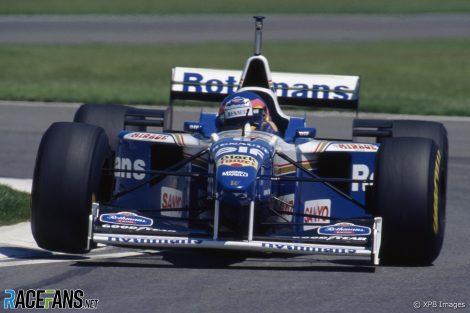
So to his scintillating F1 debut in March 1996 in Melbourne, simultaneously the city circuit’s maiden event: “I was happy with the season starting on a new track for everyone, because then Damon wouldn’t have an advantage. It turned out to be my best track through the years; lap time wise, qualifying wise, it was always my best track.
“We could really judge how good a season we were going to have based on Australia. If we were terrible in Australia we knew the season would be long and arduous.”
He started his first grand prix from pole position – emulating Mario Andretti – then led until the closing stages when forced to slow due to an oil leak after a pipe had been fitted incorrectly, but still Villeneuve finished second. He spun off (in the wet) in the next race in Interlagos, placed second in Argentina and won the European Grand Prix at the Nürburgring. Not a bad opening salvo from a rookie.
The ambitious Jock Clear was making his transition from design to race engineering, and between them they adapted CART techniques to F1.
“He was really excited and open-minded about trying stuff. We spent a lot of time exploring. In Imola he did a blind test, did the opposite of what I asked just to see if what I was saying was true. I did a few laps and told him right away he went the wrong way. From that moment onward he really believed and trusted what I was saying, and vice versa.
“I brought a lot from [CART] as well. Radio communication wasn’t really the habit in F1; playing with front wings during pit stops, that was not part of F1 [then]. So, there was a lot of things like that we worked on during the year, and that’s how we managed to invent some pretty funky setups.”
Villeneuve finished the 1996 season second, 19 points behind to champion Hill – who was nonetheless shown the door by Williams – and an equal number ahead of Schumacher who was in his first season with Ferrari.
Hill’s pending departure meant development of FW19 was mainly left to JV: “That car was designed a lot by me, working on the car for the second half of ’96. That car in qualifying was amazing, I could do whatever I wanted with it. In qualifying even when I thought I was on the limit, but we weren’t on the pole, we’d find a way to get an extra couple of tenths in the last lap.
Advert | Become a RaceFans supporter and
“It was fun fine tuning because the window of usage was very tiny. It was easy to get out of that setup window, but that made it fun. You could work on setup the old-fashioned way, and not just relying on computers, but by feel.”
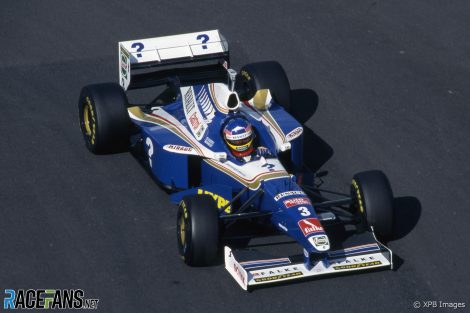
Intriguingly, in qualifying for the opener in Melbourne Villeneuve aced Schumacher by almost two seconds; come the (infamous) title showdown in Jerez where the German unsuccessfully attempted to torpedo the eventual champion they tied in qualifying.
Seven months earlier he’d beaten Schumacher to pole position in Melbourne by over two seconds. So how did they end up so close at the end of the year? Villeneuve puts this down to numerous factors, such as Melbourne being his best circuit. He also admits car development tailed off and that Ferrari started to come on strongly after team boss Jean Todt recruited heavily, not least Benetton’s engineering duo of Ross Brawn and Rory Byrne.
“[Williams] reacted and started pouring money into the car again because they realised we were about to lose the championship. So, a lot of the money and work went back into [FW19] instead of the 1998 car.”
It worked: After seven wins to Schumacher’s five Villeneuve took the title by a notional three points from the German, who was excluded from the championship for his clumsy clatter into Villeneuve in Jerez. Villeneuve got to keep the car, but sold it about 10 years ago to former Williams shareholder Brad Hollinger, who races it in USA historic events.
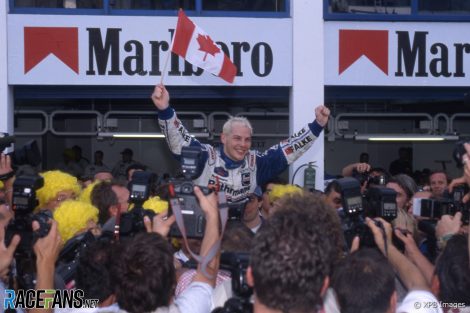
FW19 was not only the last Williams car to win a title but the last Williams designed by Adrian Newey, who departed for McLaren – then to Red Bull – and further title successes.
Apart from Newey’s departure, 1998 brought further change for Williams and Villeneuve. Renault withdrew as official engine supplier, handing its technologies to Mecachrome. Meanwhile F1 misguidedly introduced grooved tyres and Rothmans exited, opening the sponsorship door to sister tobacco brand Winfield, which bedecked the Williams cars in an unfamiliar red and yellow livery.
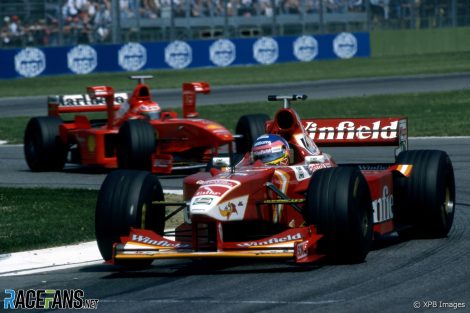
“We managed to get a couple of podiums, and once in a while we managed to be quick by running full bump rubbers, no springs almost, just like a kart, sliding everywhere. In Monza we put weight in the nose in front of the wheels, which you never do. It was that kind of car…”
In his inimitable style Villeneuve was vocal about the introduction of grooved rubber – later resorting to expletives which earned him a caution from then-FIA president Max Mosley. Did he feel vindicated when F1 dropped grooves 11 years later?
“What’s the use? It was obviously not F1; it was not the right thing to do. The problem is: I didn’t say it was a mistake, I used some vocabulary that shouldn’t be used. That didn’t go down well, which is understandable. It wasn’t very educated. But yes, [grooved tyres] wasn’t the right thing to do. But at the end of the day it was the same for everyone.”
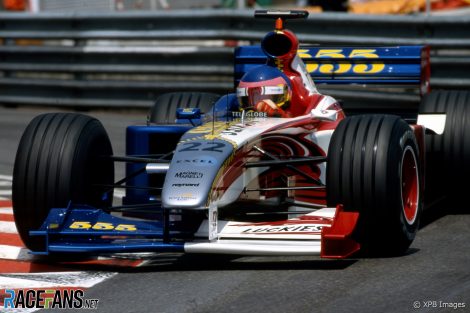
“It was a fun project ultimately to try to build your own team, but doing both driving and building your own team is not the most intelligent thing to do,” he says wryly. “The issue is [BAT] were also a part owner of the team, creating problems when you need to add to the budget: Does [BAR do so] as sponsor or shares? That created all kinds of problems.”
Malcolm Oastler, working as an employee of F3/CART stalwart and BAR technical partner stalwart Reynard, designed the Mecachrome-powered BAR 01, which Villeneuve says “wasn’t a slow car at all, but it was overly fragile. It wasn’t easy to set up, but we could get some lap time out of it.”
The ex-Renault engines, badged as ‘Supertec’ after Flavio Briatore took over their distribution rights, had “hardly gone uphill” since taking him to the 1997 title he says, adding, “There had been small evolutions, but nothing major. And they vibrated a lot.”
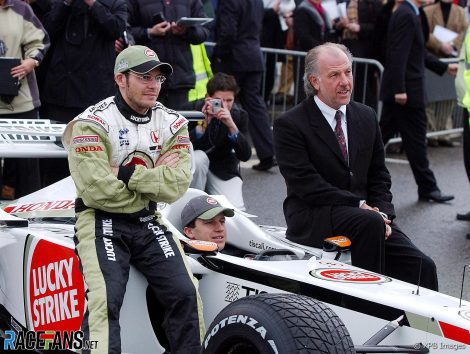
For 2000 BAR signed with Honda – starting a partnership that lasted until the Japanese company’s exit at the end of 2008, when the team mutated into Brawn before being sold to Mercedes – and things immediately looked brighter, with Villeneuve placing fourth in Melbourne in BAR 02. However, the relationship was fraught, with Honda going for headline horsepower numbers.
“It was a very peaky engine, what was important was to show how much horsepower at top revs even if the rest of the engine was empty. And it was breaking a lot.
“That was difficult, but we could deal with it – they were working hard spending a lot of money. But also, it was difficult – we were running two sets of data acquisition, because Honda were wanting to run their own to then move to it. That added complexity to the car.
“They also started designing wings, brakes and it didn’t work. We tried their front wing and as soon as you turned the wheel, it lost all downforce. When they came up with their own brakes I refused to test them, [Olivier] Panis tested them. It was in Barcelona, he got out of the pits, in turn four the brakes exploded. In the afternoon, they put a new set of brakes, turn four exploded again. There were these kinds of issues.”
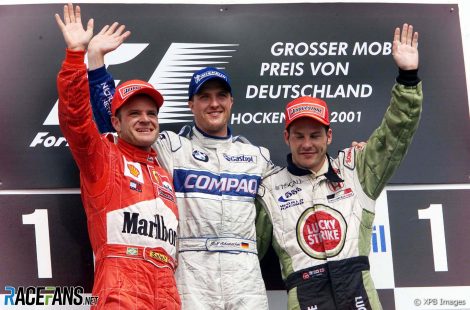
For 2002, Villeneuve considered moving to Renault, formerly Benetton, after team boss Briatore – who had access to Mecachrome data via Supertec – offered him a seat, but pressure from Honda saw him remain with the team he co-founded. However, before the season started Pollock was ousted by rally entrepreneur David Richards, whose Prodrive Subaru team was 555-sponsored. Prodrive also assumed technical duties.
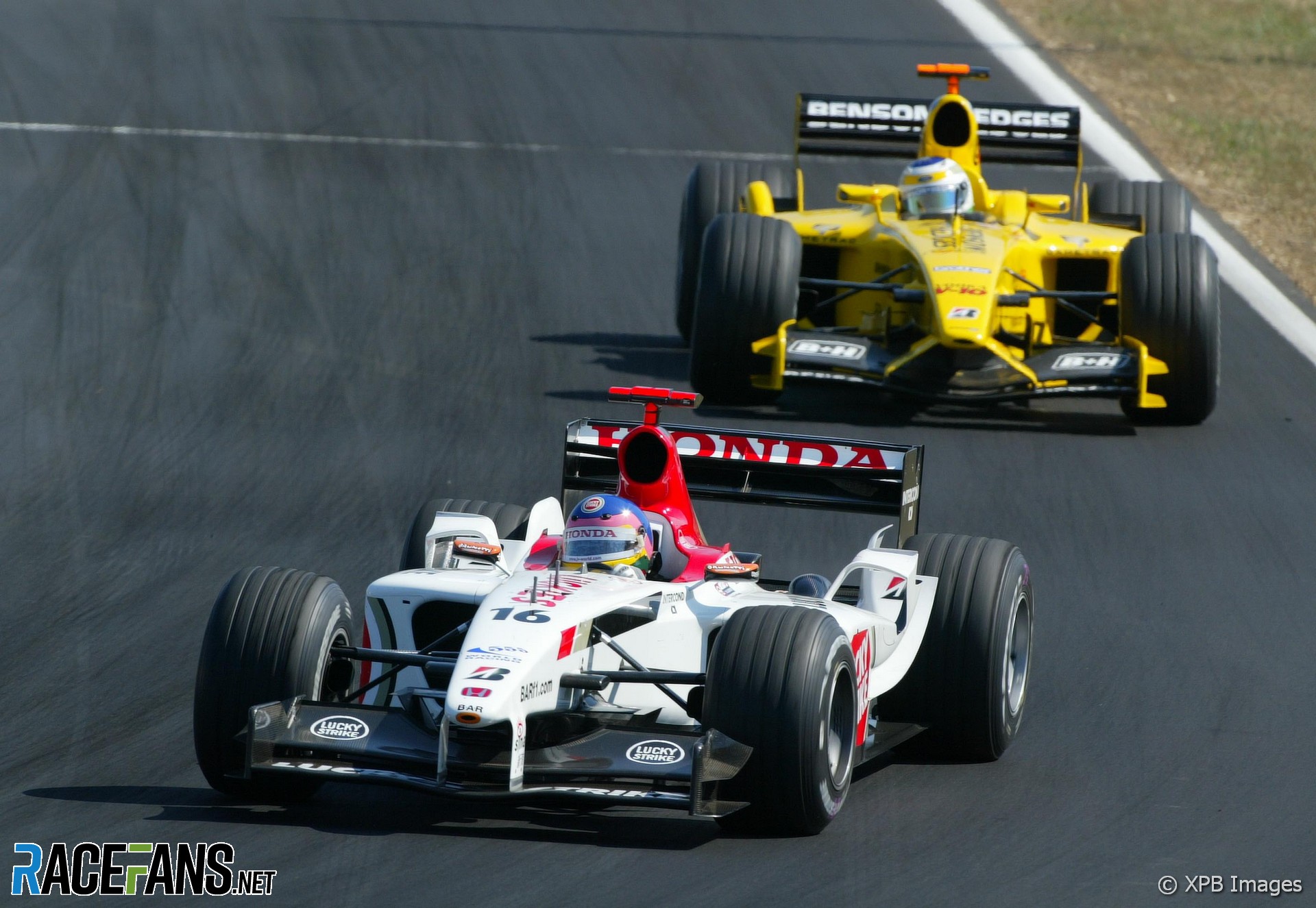
The season was a disaster all round, with BAR 04 recording seven retirements and finishing in the points just twice for 12th in the championship with four points. 2003, his final season with BAR, proved little better – 16th albeit with six points after two sixth places, the points structure now paying down to eighth place.
Villeneuve recalls: “It was just the same. The regulations weren’t changing that much and there was just a general evolution, but we didn’t get any better. We kind of stayed stuck where we were. The last two years the cars just kept breaking down, which was crazy.”
He left BAR after being offered a zero dollars contract coupled to a results bonus and image rights payments, which, he says, he was prepared to consider subject to a switch to Michelin tyres, which he believed would deliver stronger results. This, he was told, was impossible, so declined the offer. Then, he says, a deal with the French company was struck five days later, leaving him without a drive for 2004.

“Alonso has his own way of driving and – hah! – no one could drive his cars, ever. I did one test, it was a strange car to drive; really, really weird. We got the car right in Brazil, so it took two races. But the set-up was completely different, it was better than Alonso’s in the wet in Suzuka. The pace was good, but he was a monster in the race.”
Still Villeneuve wasn’t finished with F1, joining Sauber for two years from 2005. Team owner Peter Sauber had hinted to Villeneuve about a manufacturer buy-out coming for 2006, but provided no details.
“The [Ferrari-powered C24] car was very difficult to drive but the guys were great. The mechanics, the guys I was working with were a lot of fun. But it wasn’t competitive enough and it was really difficult because I didn’t get along with Willy Rampf, who designed the car.
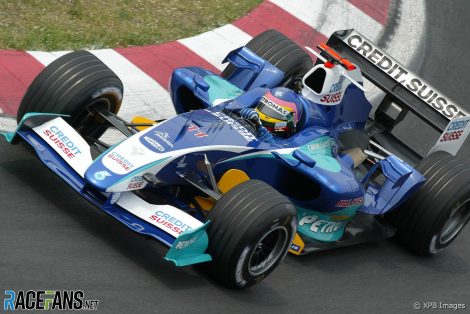
“At some point I had to complain in the media and the next race I was three or four-tenths quicker and I saved the tyres. Two races later they put [my settings] on [Felipe] Massa’s car as well and he was also quicker.
“From then on Willy was angry with me and it just never worked because I went against the team and it was better. So that created a big issue.” The result: 14th with nine points.
The manufacturer duly arrived in 2006: BMW, which had acquired a majority shareholding in Sauber. Clearly Villeneuve was not wanted, as his first dialogue with team boss Mario Theissen made clear.
“I got a call and I was told ‘by the way, we don’t want you’. I said ‘I’ve got a contract, I’ll be racing.’ That’s how [the relationship] started…”
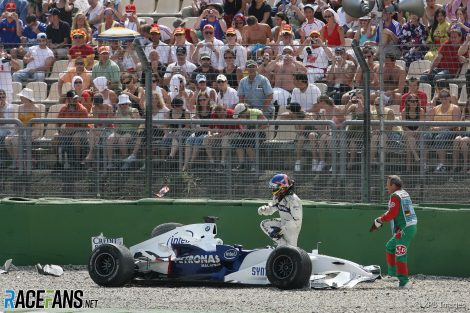
The next day Theissen called, saying Villeneuve was unfit to drive in Hungary, having allegedly injured himself during the Hockenheim incident, but then offered a Friday FP1 stint.
That brought the career of a world champion and 11-time grand prix winner to an abrupt end. Today he races where and what he can on a ‘have helmet, will race’ basis – between stints as F1 expert for Sky Italia and TF1. A multi-tasker, even with media work.
My F1 Cars
- Hill on Williams’ dominant cars, Brabham’s last gasp and the “worst decision” F1 ever made
- Herbert on his painful debut, Schumacher’s title-winning Benettons and more
- ‘Aston Martin still use my steering wheel design’ – Liuzzi on his F1 career in cars
- Coulthard on the CVT Williams, McLaren’s little-known tricks and Newey’s first Red Bulls
- My F1 Cars: Webber’s route from ‘pain in the ass’ Minardi to all-conquering Red Bull





Aleš Norský
22nd June 2021, 12:28
Don’t forget Carlos Reutemann’s rookie pole…
Clemens Wenners (@clemenswenners)
22nd June 2021, 12:44
Still one of the most beautiful helmets to ever race in F1.
Dave
22nd June 2021, 16:34
Definitely!
Robbie (@robbie)
22nd June 2021, 21:56
Agreed
Ambrogio Isgro
22nd June 2021, 13:06
Really interesting as usual.
The comment on undriveable Alonso cars, confirms something I always suspected, that explain in part the difficulties of his teammates Massa and Raikkonen
Exediron (@exediron)
22nd June 2021, 14:07
I think Villeneuve was just talking about Alonso’s setup, not the cars of Alonso-led teams in general. Massa and Raikkonen presumably uses their own setups.
Mashiat (@mashiat)
22nd June 2021, 14:29
I don’t necessarily agree with that. Raikkonen continued to struggle at Ferrari even after Alonso left, so I think we were just seeing what Raikkonen was as a driver at that time. Of course, the car didn’t suit him, but that probably accounted for only a small portion of the deficit. The same goes for Massa. I always just thought that was his level. His move to Williams didn’t convince me otherwise, he was soundly beaten by Bottas, who we now know is no top-level driver.
frood19 (@frood19)
22nd June 2021, 22:16
I’ve always seen it that way too – alonso was on another level entirely compared to massa and raikkonen.
Buzz
22nd June 2021, 13:18
Just a correction : Villeneuve provides his expertise for canal+ and not TF1 on french TV as TF1 does not broadcast F1 anymore.
Robbie (@robbie)
22nd June 2021, 14:25
Thanks for this @dieterrencken and Jacques. You were a monster behind the wheel too JV.
Roth Man (@rdotquestionmark)
22nd June 2021, 15:08
Really enjoyed this thank you. I know he divides opinion now but I loved Jacques, I got into F1 in 1997 and was obsessed with him and Williams. Loved his raw pace and daredevil style and one of the few to speak up when others wouldn’t. Always breaks my heart how it all fell apart post 2002 but on his day he was relentless. The helmet colours still fill me with a nostalgic happiness.
Robbie (@robbie)
22nd June 2021, 22:19
@rdotquestionmark So well said and I’m with you. I had assumed all along your moniker was because of JV but of course it could have been DH as well lol.
I knew I was going to be a fan of JV’s from the minute I heard that the son of Gilles was actually going to be a race car driver. My tenure with F1 started before Gilles’ entrance into F1 brought TV coverage to Canada in 78/79. I’d follow it from newspapers and books at the library prior to CBC bringing it to Canada on TV.
As with some others here I count myself among the upper echelon of fandom towards JV. I’m chuffed to hear such positivity towards him in these comments as I am so accustomed to him being slammed for his strong opinions which has always made me feel too many people have no idea just how good a racer he was.
I could go on and on but are you folks familiar with Area 27? It’s a track in British Columbia that JV helped design and it is amazing. I’m not sure if he has involvement in the track beyond having helped design it but here’s a link about the track and then you can also google for Area 27 for the website or Facebook and Instagram pages.
https://www.avionmotorsports.com/the-track
JohnnyRye (@)
22nd June 2021, 23:51
Area 27 is only a couple hours from me. Raced there last October and likely again in the fall.
One of the most difficult tracks I’ve raced. You never feel like you aced a lap. Having been a lifelong JV fan and listening to the types of tracks and corners he liked, you can tell this was his track because it uses the landscape properly.
Robbie (@robbie)
23rd June 2021, 4:25
@johnnyrye So cool. Thanks for that. What were you driving?
JohnnyRye (@)
24th June 2021, 17:31
@robbie.
Great link! Loved the details and depth of thought.
A CRX in a couple 7 hour races with the PNW endurance series
Roth Man (@rdotquestionmark)
23rd June 2021, 8:36
That’s really interesting @robbie I’ve loved reading all the folklore and stories over Gilles he must have been really special. Favourite being the story of Jody scarring himself silly in the wet practice session on the limit and looking at the timing screens to see he was 7 seconds slower than Gilles or something crazy.
Jacques was an enigma and people like to beat on him for the way his career tailed off and his outspoken opinions. But the truth is he was exceptional until 2003 when the relationship with Richards, BAR and Button turned absolutely toxic, he never seemed the same again. There was a huge period where he was the second most valuable asset on the grid behind Michael and always rumours of him joining Mclaren and Renault. The Mclaren one I would have loved to have seen but not to be.
The moniker is for the 97 season and the rdotquestionmark was the code livery they used at Silverstone, the first GP I attended at 11 years old. Which Jacques won.
I remember reading about the track he designed, I’ve watched onboard footage from track days in the past and it looks an incredible layout.
Mooa42
23rd June 2021, 8:22
@rdotquestionmark
” Always breaks my heart how it all fell apart post 2002 but on his day he was relentless.”
I vaguely recall reading an article about JV from around 2002 which described his life growing up, a passion for extreme sports, like downhill skiing, and I remember that he had never had any sort of accidents, injuries or even crashes as a kid. All of which must build your self belief that you are somewhat indestructible. I always felt that his 2001 crash in Melbourne with Ralph Schumacher, which resulted in the death of a track marshall, was the beginning of the end for JV, I think it hit him very hard, even though it was a racing incident it was a big crash down to earth for Mr Indestructible.
Roth Man (@rdotquestionmark)
23rd June 2021, 8:40
That’s a great point, I forgot about that, it did hit him hard. I even remember Montoya calling him a murderer and Villeneuve grabbed him by the throat over an on track dispute. Perfect storm of the marshal death, his team gamble not working out, Richards coming in in 2002 and then the arguments over pay and clearly not wanting him there. He never seemed the same again.
ferrox glideh (@ferrox-glideh)
24th June 2021, 3:42
Back in 77 Gilles and Peterson came together in Japan resulting in the death of a marshal and a photographer. I bet that stuck in young Jacques memory, and would have been nightmare fuel enough for a young racer. When a similar thing happened to himself, well, it must have been a real sickener.
Markus (@aesto)
22nd June 2021, 15:57
Great article, I hope there’s more to come on drivers from the 90s. As a kid, I was a big Schumacher fan, so Hill and Villeneuve were my villains. As an adult, it’s so interesting to read about how my childhood villains were very thoughtful and interesting people. I already got a good amount of information from Hill’s and Newey’s books (both great), and this article filled in some of the gaps.
G (@unklegsif)
22nd June 2021, 17:03
Ditto me with Senna and Schumacher – as a kid I was a Prost DC, Hill and Hakinnen fan, so they were just the natural “sworn enemy”. Only with hindsight do you see the other side of them and appreciate their greatness
G
Nick T.
22nd June 2021, 21:31
And not being a child anymore helps. When I read invective posts about one drive or another, I automatically assume the commenter is still a school age kid.
Jorge Salgueiro
22nd June 2021, 17:56
He could try the 3 crown…
Fer no.65 (@fer-no65)
22nd June 2021, 18:37
This is the one I wanted to read. Jacques was the kind of driver that excited me back in the 90s. And reading about him later, way past his F1 days, made me realize how good and unusual a driver he was. He was a bit of a joke in the later years, but a lot of his points were bang on. I remember him going public against Sauber for not taking advantage of the rule allowing teams on the lower half of the grid to use a third car. BAR in 2004 and McLaren in 2005 surely got a lot of info that translated into the good results they had, yet Sauber ran two cars always.
It’s one of those guys that you don’t fully understand how they weren’t more sucessful, how they gathered the wrong people around them or chose the incorrect path. A bit like Alonso, only Fernando kept delivering even with the odds against him.
Tifoso1989 (@tifoso1989)
22nd June 2021, 19:38
A joy to read as usual, thanks a lot Dieter !
Not to mention that I’m a massive JV fan who started following F1 just by the time Jacques joined the sport. As a kid who used to watch F1 on the French and Italian channels and didn’t understand a single word. JV somehow grabbed my attention even though I’m a natural Ferrari fan. He is an original, instinctive, never boring type and he is usually spot on in his analysis.
Jacques is commenting the races live on Canal+ in French and doing the analysis before and after the sessions for Sky Italia in Italian ! In the French GP he wasn’t spot on as usual, he predicted Hamilton will survive Verstappen’s attack because he thought Verstappen will run out of tyres at the end of the race.
Rodric Ewulf
22nd June 2021, 20:24
That one was really difficult to predict, it was a pleasant surprise indeed! Max made something that looked like magic I suppose.
Rodric Ewulf
22nd June 2021, 20:26
With the Red Bull backing him up on a ballsy strategy, of course!
Tifoso1989 (@tifoso1989)
22nd June 2021, 21:37
Indeed, it was a surprise because he lost a bit of pace when he caught Hamilton but he just had enough to make his move.
x303 (@x303)
23rd June 2021, 23:14
Oh, that explains why he always disappears when the chequered flag is dropped.
Nick T.
22nd June 2021, 21:27
Fantastic story. Finally, some reporting that gives us facts and info that aren’t self-evident or redundant.
The amount of testing JV had makes his WDC even less impressive, but the guy won CART and the Indy 500 at their peak. So, hard to argue he didn’t have raw talent. Just never made much use of it after his WDC.
Lopes da Silva
22nd June 2021, 22:03
In my childhood, I was a regular F1 and Senna but I didn’t watch every race. I was schocked, as every 11-year old across thr world, on 1994 May 1st and 2nd. No one was talking about other stuff at school on May 2nd. I kept watching but still not regularly, and neither Schumacher nor Hill enthusiasmed me. In 1996, God knows the reasons, I thought JV was a good pick. For personal reasons, from the Hungarian GP onwards I started watching every single race, and I kept that way for many years, until Portuguese television dropped the free-to-air. JV won that Hungarian race and I got thrilled that, after all, he still had a chance for the 1996 championship.
Of course Jacques shouldn’t have left Williams. I would have loved to se him with the Williams-BMW. Surely he was not the best wet weather driver. Nonetheless it was great fun to follow him through those years, even if we were later focusing on Schumacher vs Hakkinen. I factually believe that he was the 3rd best of the field in 1998 and in 2000 and that people’s rating of JV are influenced by his later years, as happened with Nelson Piquet. Even more for his post-f1 commenting. Too much people rate drivers for their personality rather that based on facts.
Alas, it was more than fun to know that the F1 driver who discovered Spa-Francorchamps by playing Microprose Grand Prix 2 in 1996 was e-racing with the simplest pad in 2020, as I’m a simple racing gamer myself. Thanks for the memories and for the more than frank comments!
PMccarthy_is_a_legend (@pmccarthy_is_a_legend)
22nd June 2021, 22:22
Villeneuve is an interesting character with lots to say. He’s always good value. Though I must say I don’t enjoy the writers writing style. To me it feels disjointed, difficult to read, sentences are somewhat poorly constructed.
I would have preferred just a simple “here’s the question I asked, followed by interviewee response” , rather than this narrative style the writer is trying (and failing) to deliver.
This just my personal opinion though.
Sam Donaldson (ABC News)
22nd June 2021, 23:48
Finally true journalism of this site…thank you…good read.
Kurt Laguna
23rd June 2021, 5:39
Really enjoy these “cars” features, always learn something about the cars and the drivers and what was really happening when these were the cars of the day. Look for more from you and keep up the great work.
ferrox glideh (@ferrox-glideh)
24th June 2021, 3:45
That was a really enjoyable article. Keep up the great work!
Sergio (@blasbri)
21st August 2021, 16:47
A jewel of an article, however it lacks something to get full marks: How can we pass on 2003 without delving into why Button did extract good performance of the supposedly awful BAR 005?